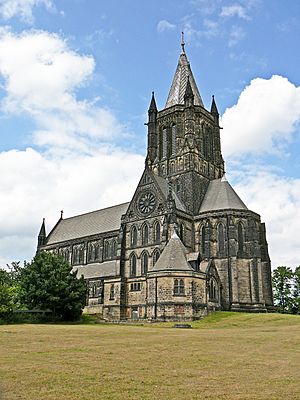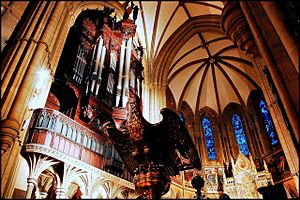St Bartholomew's Church, Armley facts for kids
Quick facts for kids St Bartholomew's Church, Armley |
|
|---|---|
 |
|
| 53°47′41″N 1°35′13″W / 53.79462°N 1.58701°W | |
| OS grid reference | SE 27301 33209 |
| Location | Leeds |
| Country | England |
| Denomination | Church of England |
| Churchmanship | Anglo-Catholic |
| Website | www.stbartsarmley.org.uk |
| History | |
| Dedication | St. Bartholomew |
| Consecrated | 1877 |
| Architecture | |
| Heritage designation | Grade II* listed building |
| Architect(s) | Henry Walker and Joseph Althron |
| Architectural type | Perpendicular Gothic |
| Completed | 1872 |
| Construction cost | £20,000 (£1,280,000 in 2021) |
| Specifications | |
| Length | 57m |
| Width | 18m |
| Height | 34m |
| Spire height | 57m |
| Materials | Horsforth sandstone |
| Administration | |
| Parish | Armley with New Wortley |
| Deanery | Armley |
| Archdeaconry | Leeds |
| Episcopal area | Leeds |
| Diocese | Leeds |
| Province | York |
St Bartholomew's Church, Armley is a special parish church in Armley, West Yorkshire. It belongs to the Church of England. This church is one of two Church of England churches in Armley. The other is Christ Church. People who worship at St Bartholomew's follow a traditional style. This is called the Anglo-Catholic tradition. They celebrate a solemn mass every week.
Contents
History of St Bartholomew's Church
The very first small church, or chapel, in Armley was built in 1630. However, it was not officially blessed until 1674 by Richard Sterne. He was the Archbishop of York.
In 1737, the chapel was made bigger. They added an extension to the north side. The roof was also made higher, and a small balcony was put in at the west end.
Building a New Church
In 1825, the chapel was greatly expanded. This was thanks to Benjamin Gott. He was a local businessman who owned woollen mills in Leeds.
A completely new church building started in 1872. It was designed by architects Henry Walker and Joseph Althron from Leeds. This new church is now a Grade II* listed building. This means it is a very important historical building.
The church was officially blessed in 1877. However, the tall tower was not finished and dedicated until 1904. The church is built from a type of stone called Horsforth sandstone. The old chapel was taken down in 1909.
Special Features of the Church
The church has many interesting features inside.
The Reredos and Pulpit
The Caen stone reredos was put up in 1877. A reredos is a decorated screen behind the altar. This one has beautiful alabaster carvings. These carvings show the Magi, the crucifixion, and figures from the Old Testament. John Wormald Appleyard was present at the blessing of the church in 1877. He was listed with the architects who designed the building. It is thought that Appleyard might have carved the reredos.
The pulpit is made of alabaster and marble. A pulpit is a raised platform where sermons are given. It was designed by architect Thomas Armfield. His design was inspired by a pulpit in Germany. This pulpit was first carved by Mawer and Ingle in 1861 for the old church. It was then moved to the new building after it was blessed. The font and old tomb memorials were also moved.
Memorials and Sculptures
At the west end of the north aisle, there is a sculpture by Joseph Gott. This sculpture is a memorial to Benjamin Gott. He was a famous industrialist from Armley House who passed away in 1839.
In the south aisle, there is another sculpture called Faith comforting the Mourner. This piece remembers two of Benjamin and Elizabeth Gott's sons. They both died in Paris and Athens. Benjamin Gott's son, William Gott, was buried in the family tomb at the old church.
The Famous Organ
St Bartholomew's Church is very well known for its amazing organ. It was built by a German builder named Edmund Schulze. The organ was first put into a place called Meanwood Towers in 1869.
In 1877, it was moved and officially started playing at St. Peter's Church, Harrogate. After some disagreements, the organ was moved again to St. Bartholomew's in 1879. It was rebuilt in 1905 by James Jepson Binns. Other repairs and improvements happened in 1956, 1974, and 2004.
The organ has a special Grade II* listing from the British Institute of Organ Studies. This means it is a very important example of its builder's work. It is also still in mostly its original condition. You can find more details about the organ on the National Pipe Organ Register.
See also
- Listed buildings in Leeds (Armley Ward)


